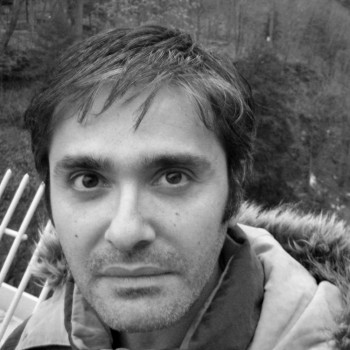edmonton AB 2012
edmonton AB
mile zero dance / february 2012

guest artist
stefano muneroni

Stefano Muneroni is Assistant Professor of Intercultural Theatre at the University of Alberta. He is a theatre historian, dramaturg and translator who has taught in Italy, England, the U.S., and Canada. His areas of specialization are Postcolonial and Border Theory, and Religious Theatre. Recent dramaturgical credits include Yerma, Angels in America, The American Clock, Tales of the Lost Formicans, The Mill on the Floss, The Toxic Bus Incident, and Old Times. Recent translations include Xavier Villaurrutia’s El ausente, Osvaldo Dragún’s Tres historias para ser contadas, and Brad Levinson’s A Ritual of Faith. He received grants to conduct research in Honduras, Mexico and Argentina, and is the recipient of a 2012 KIAS Cluster Grant to research the post 9/11 Mexican-American border. He has published academic articles on Latin American theatre, religion and drama, and translation.
notes
stefano muneroni
RE-WRITING DISTANCE workshop
february 20, 2012
Three veils of different shades of blue,
Layered so that you have to take in all three at the same time.
They are layers whose very presence metaphorizes the composite and multiple natures of this space, its history, its mission, and its misguided uses.
Those veils hide without hiding what is behind … what is behind is visible in transparency. They tantalize the viewers with a promise of “what could be,” a treasure, the key to understand the nature of this space, perhaps the very appearance of a performer who is waiting behind this made-up curtain to entice us with his sensuous body.
I wonder whether it was the color that attracted me to those veils … the heavenly blue … or their silky texture, which responds to wind and breath so willingly, almost lovingly. Maybe I was drawn here because in the midst of hard surfaces and cluttered spaces, the hopeful color and its mobility invited some sort of understated and flawed hope.
february 21, 2012
Re-writing: there is communication in words because they anchor significance to reality and identity. However, one should be proactive in locating meaning also in silence and movements and attune to different ways to bridge the chasm between the individual and the world, to mediate what we know and what we hope to know in the future.
Moving away from the failure of objectivity and learn to embrace ambiguity and impreciseness as qualities I can use in my research as a human being (first) and a scholar.
Jacques Derrida called it the ‘interval,’ the space where one negotiates the presupposed totality of language with the very awareness that our vocabulary is arbitrary, that it does not make sense in itself but only in relation to a complex system of signification. “What is” is only understood through “what is not” and “what is similar” or “what is different.”
There is more to dance and writing than movement and text.
There is more to the two of them together than their mere addition.
I feel one must reconfigure a completely new way to articulate their differences before even thinking that they can become one practice.
How does dance mirror the syntax and grammar of language? How does a visual text compare to a written or verbal one? What happens when the audience experiences them together? I find that those are questions one must answer to start unpacking the full potential of the relationship between movement and writing.
I feel that I have to let go of my anxiety for words if I want to approximate an answer to those questions. More listening and less talking! Approaching the third space.
notes
guy cools
week 3 February 20th till 24th
with Stefano Muneroni in Edmonton, Canada)
day 1
Starting point. Miranda’s exercise of discovering the space.
A space of confusion, both visually and acoustically; with a lot of blurred information at the edges; a lot of layers on top of each other; different colours; different sounds; wind playing with fabric; the reflection of the sun on cars passing by. The inside reflects the outside.
Four circles of increasing complexity. The smallest, inner circle: just a horizontal line; the horizon?; the border, the edge. The second circle: a human figure and the letter A – the beginning of mankind? The third circle: a cross under a bridge or a mountain – our destiny? The fourth circle: three almost parallel lines, a crowd next to a house on legs – three always know more than one and this room has legs, is fluid like all the rivers we visited.
A line of circles. A circle of lines. Breaking the symmetry of the framing.
I am curious now how it will sound but I decide to wait for the moment to arrive later, when this will reveal itself as part of a larger story, our story.
Let’s talk!
notes
lin snelling
rewriting distance, Feb. 20
monday
(the following writing is from Miranda’s exploration of space that we did first off)
It starts with a soft red vase;
some small flowers and an invitation from this
space to notice how much red there is here;
red bowls
red roses
a tin that says
“Value Red”
perhaps this is the point
value red
as I look into this
domestic kitchen space at one side of the studio
I notice and
remember
that once upon a time
my nickname was Red …
haven’t thought of that in years
in fact I forgot completely until just now
“Value Red”
as I look up to a framed photograph
of parts of a body
with red tape through the center
on purpose
red tape
has another meaning not at all
like this
champagne box underneath
this framed photograph
Veuve Clicquot,
as I step into the kitchen and
notice the red fire extinguisher
and the red bowl with an orange
in it.
Rainbow cup is in
front of me,
by the sink,
and now,
I turn and sit at the
counter and see out the window
in front of me
an old Coco Cola sign
also with bits of red
there is someone writing in front of the window.
If I add an A to RED
it becomes
Read
Comments Off on edmonton AB 2012
